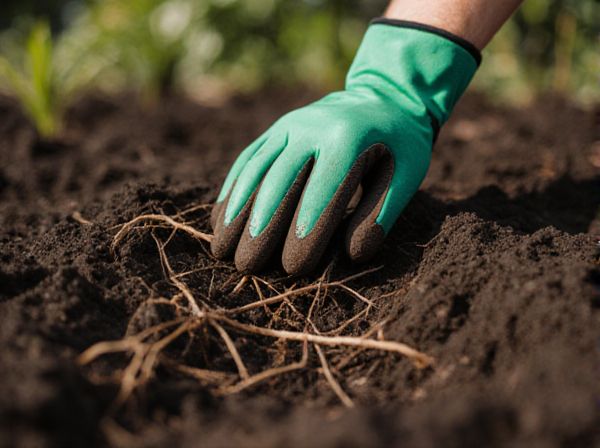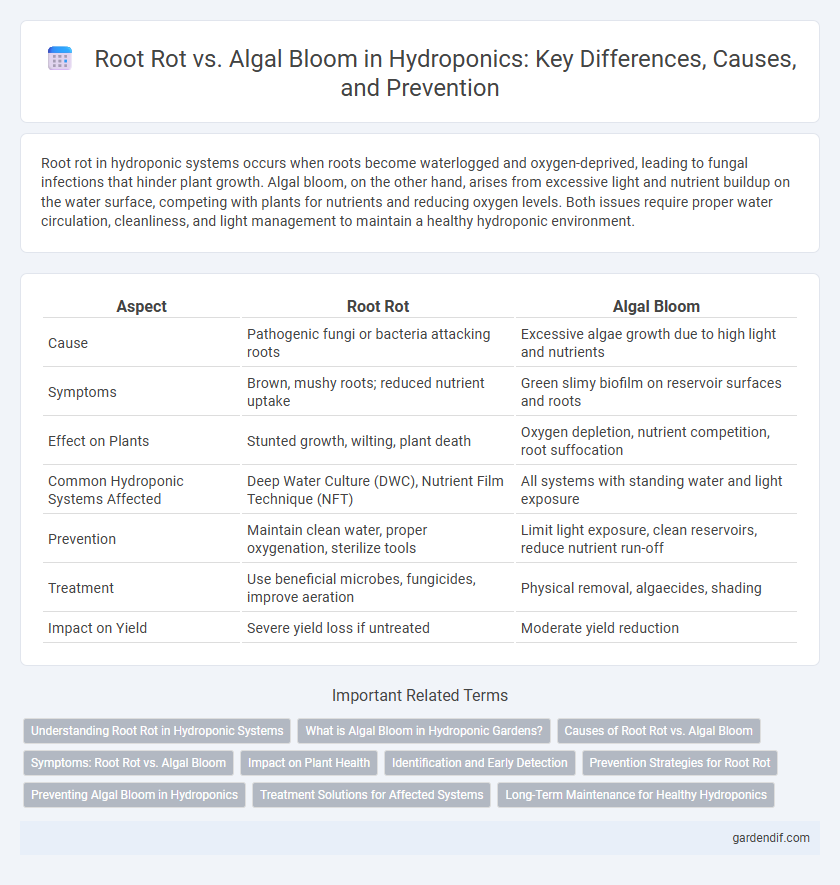
Root Rot vs Algal Bloom Illustration
Root rot in hydroponic systems occurs when roots become waterlogged and oxygen-deprived, leading to fungal infections that hinder plant growth. Algal bloom, on the other hand, arises from excessive light and nutrient buildup on the water surface, competing with plants for nutrients and reducing oxygen levels. Both issues require proper water circulation, cleanliness, and light management to maintain a healthy hydroponic environment.
Table of Comparison
| Aspect | Root Rot | Algal Bloom |
|---|---|---|
| Cause | Pathogenic fungi or bacteria attacking roots | Excessive algae growth due to high light and nutrients |
| Symptoms | Brown, mushy roots; reduced nutrient uptake | Green slimy biofilm on reservoir surfaces and roots |
| Effect on Plants | Stunted growth, wilting, plant death | Oxygen depletion, nutrient competition, root suffocation |
| Common Hydroponic Systems Affected | Deep Water Culture (DWC), Nutrient Film Technique (NFT) | All systems with standing water and light exposure |
| Prevention | Maintain clean water, proper oxygenation, sterilize tools | Limit light exposure, clean reservoirs, reduce nutrient run-off |
| Treatment | Use beneficial microbes, fungicides, improve aeration | Physical removal, algaecides, shading |
| Impact on Yield | Severe yield loss if untreated | Moderate yield reduction |
Understanding Root Rot in Hydroponic Systems
Root rot in hydroponic systems is primarily caused by pathogenic fungi such as Pythium, which thrives in oxygen-deprived, overly wet environments, leading to decayed, brown, and mushy roots. This condition disrupts nutrient and water uptake, severely stunting plant growth and potentially causing crop failure. Effective management involves maintaining optimal oxygen levels in the nutrient solution and preventing pathogen introduction through sterilized equipment and clean water sources.
What is Algal Bloom in Hydroponic Gardens?
Algal bloom in hydroponic gardens refers to the rapid growth of algae on nutrient solution surfaces, pipes, and growing trays, which competes with plants for light and nutrients. This phenomenon commonly occurs due to excessive light exposure, high nutrient levels, and inadequate sanitation practices. Managing algal bloom involves reducing light penetration, maintaining clean equipment, and optimizing nutrient formulations to prevent algae proliferation and preserve healthy plant growth.
Causes of Root Rot vs. Algal Bloom
Root rot in hydroponic systems is primarily caused by overwatering, poor oxygenation, and pathogenic fungi like Pythium, which thrive in stagnant, nutrient-rich environments. Algal bloom, on the other hand, results from excessive light exposure, nutrient imbalances, and warm temperatures that promote rapid algae growth on nutrient solutions and surfaces. Understanding these distinct causes is essential for maintaining healthy hydroponic crops and preventing root damage or algae-related nutrient competition.
Symptoms: Root Rot vs. Algal Bloom
Root rot in hydroponic systems manifests as brown, mushy roots with a foul odor, indicating oxygen deprivation and pathogen infection, while algal bloom typically appears as slimy, greenish surface growth on the nutrient solution or system components, obstructing light and oxygen flow. Root rot symptoms include stunted plant growth, wilting, and yellowing leaves due to root decay, whereas algal bloom primarily causes reduced oxygen levels and nutrient competition, leading to weaker plants without direct root tissue damage. Identifying these distinct symptoms promptly helps maintain system health and optimize crop yield in hydroponic cultivation.
Impact on Plant Health
Root rot in hydroponic systems causes severe damage to plant roots by creating anaerobic conditions that lead to root decay and reduced nutrient uptake, ultimately stunting growth and increasing plant mortality. Algal bloom, while less destructive to roots, can block light and compete with plants for nutrients, resulting in slower development and decreased yields. Managing water quality and system hygiene is critical to prevent both root rot and algal bloom, ensuring optimal plant health and productivity.
Identification and Early Detection
Root rot in hydroponics is identified by brown, mushy roots with a foul odor and stunted plant growth, often caused by pathogens like Pythium. Algal bloom appears as slimy green or brown patches on nutrient solution surfaces and container walls, reducing oxygen levels crucial for healthy root function. Early detection involves regular visual inspection of roots and nutrient solutions, combined with monitoring water quality parameters such as pH, temperature, and dissolved oxygen.
Prevention Strategies for Root Rot
Effective prevention strategies for root rot in hydroponic systems include maintaining optimal oxygen levels in the nutrient solution to inhibit anaerobic pathogens like Pythium. Regular monitoring and controlling water temperature between 18-22degC reduces microbial growth that can cause root decay. Utilizing sterilized equipment and implementing UV sterilizers or beneficial microbes, such as Trichoderma, are essential to protect root health and ensure vibrant plant growth.
Preventing Algal Bloom in Hydroponics
Controlling nutrient levels and maintaining proper water circulation are crucial for preventing algal bloom in hydroponic systems. Using opaque containers and minimizing light exposure on nutrient solutions reduces algae growth by limiting photosynthesis. Regular cleaning of grow trays and monitoring pH levels between 5.5 and 6.5 also inhibit algal proliferation, ensuring healthier plant roots and nutrient uptake.
Treatment Solutions for Affected Systems
Root rot in hydroponic systems requires immediate removal of infected roots and use of beneficial microbes like Trichoderma to restore root health and prevent fungal spread. Algal bloom treatment involves reducing light exposure, improving water circulation, and using hydrogen peroxide to eliminate algae without harming plants. Maintaining optimal water pH and temperature levels supports recovery and prevents recurrence of both root rot and algal bloom in hydroponic setups.
Long-Term Maintenance for Healthy Hydroponics
Root rot and algal bloom are common hydroponic challenges requiring tailored long-term maintenance strategies to sustain plant health and system productivity. Prevent root rot by maintaining optimal oxygen levels in the nutrient solution, ensuring proper drainage, and regularly sterilizing equipment to inhibit pathogenic fungi such as Pythium spp. Control algal blooms through limiting light exposure to nutrient reservoirs, frequent cleaning of surfaces, and monitoring nutrient concentrations to prevent excess organic matter that fosters algae growth.
Root Rot vs Algal Bloom Infographic

 gardendif.com
gardendif.com